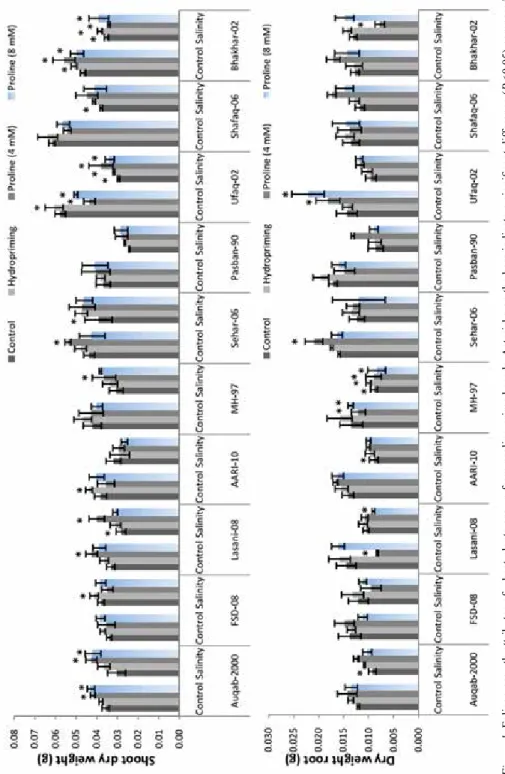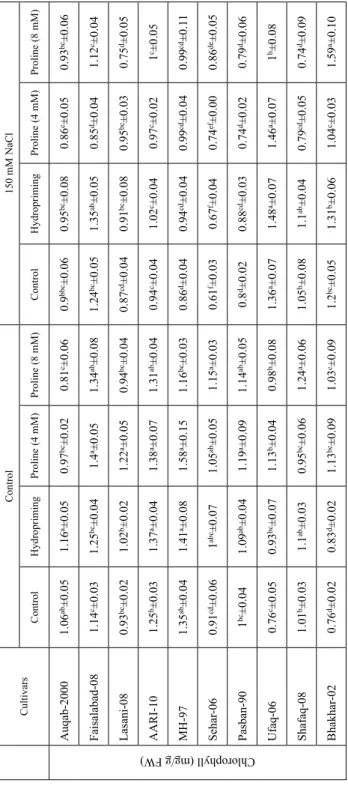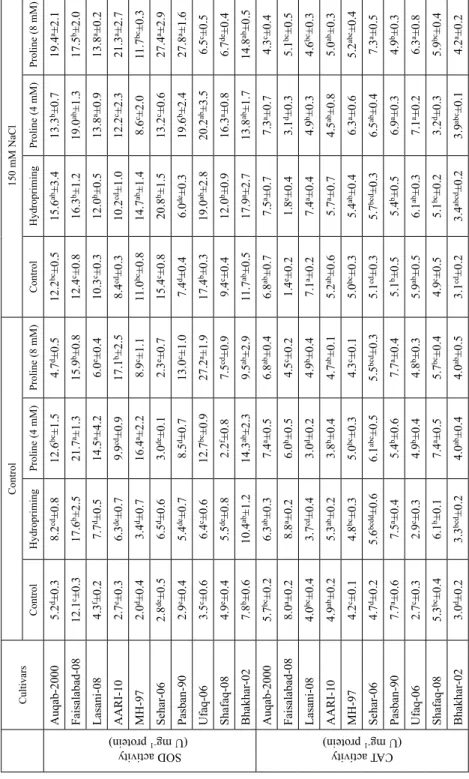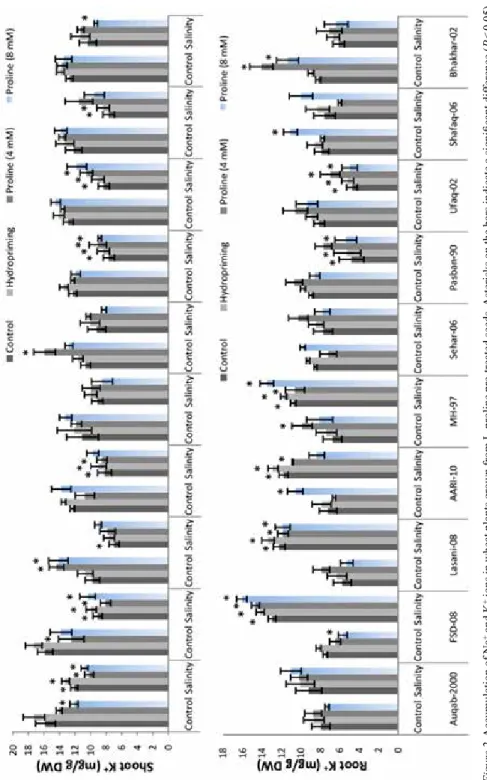Influence of Proline Priming on Antioxidative Potential and Ionic Distribution and its Relationship with salt Tolerance
of Wheat
F. ShaFiq*, S.h. Raza, a. BiBi, i. Khan and M. iqBal
Department of Botany, Government College University Faisalabad, Punjab, Pakistan (Received 26 April 2017; Accepted 14 August 2017;
Communicated by A. Pécsváradi)
Mechanisms involved in salt tolerance urge exploration and investigation of genotypic variation to assist future breeding programs. Comparative examination of ten wheat cultivars for salt tolerance and their response towards proline-seed-priming was performed. Exposure of wheat seedlings to salinity resulted in prominent reduction in root and shoot growth attrib- utes of all cultivars. Furthermore, decrease in the chlorophyll contents was evident although this varied among cultivars. Wheat seedlings grown from proline pre-treated seeds exhibited improved photosynthetic pigments, besides this response was also cultivar and concentration dependent. Generally, salt stressed plants exhibited higher antioxidant enzyme activities.
Proline priming significantly influenced antioxidant activities, however, its magnitude var- ied. The peroxidase activity varied among wheat cultivars that were evident from the analy- sis of POD activity on Native-PAGE gel. Salinity caused the accumulation of Na+ in the roots and the magnitude of Na+ translocation to the shoot was cultivar dependent. Similarly, K+ uptake and its distribution among root and shoot varied. Priming treatments affected ion distribution of Na+ and K+ but inter-cultivar variations were evident. Conclusively, all the cultivars investigated exhibited differential response to salinity and proline seed pre-treat- ments. However, the proline-priming mediated improvements in growth and antioxidant enzyme activities contributed to stress tolerance which partly relied on the ability of the plant to uptake sodium and its partitioning in the roots. Of the cultivars tested, Faisalabad-08 and Bhakhar-2002 were ranked as relatively salt tolerant and the cvs. AARI-10, MH-97 and Auqab-2000 as relatively salt sensitive.
Keywords: catalase, peroxidase, proline, priming, salinity, superoxide dismutase, wheat
Introduction
Salinity is a global agricultural problem mainly associated with arid and semi-arid re- gions (Schleiff 2008). About 20 percent of the total irrigated and 6 percent of the global agricultural land is declared as salt affected (FAO 2008; Sileshi and Kibebew 2016). El- evated soil salt levels suppress plant growth and productivity posing a serious threat to agriculture and food sources (Koevoets et al. 2016; Daliakopoulos et al. 2016). Of the total area under wheat cultivation in Pakistan, a significant area is severely salt affected
*Corresponding author; E-mail: fahadsheikh1800@gmail.com
(Murtaza et al. 2017). In general, salinity induces metabolic imbalance / oxidative stress that in turn damage vital cellular components including DNA and lipids (Apel and Hirt 2004). In opposition, enzymatic and non-enzymatic antioxidant defense system counter oxidative stress (Mittler 2002). It is proposed that plants exhibiting higher activities of antioxidant enzymes conferred resistance to oxidative damage (Hernandez et al. 2009).
Salt tolerance mechanisms are broadly classified into three main categories viz. os- motic tolerance, ion exclusion and tissue tolerance (Roy et al. 2014; Forni et al. 2017).
Salinity tolerance mechanisms in plants are still unresolved despite of extensive research and success in developing tolerant genotypes is so far limited (Roy et al. 2014). There is no authentic criterion for the screening/ identification of salt tolerance due to extensive genetic variability. Specific changes initiated when salinity stress is exerted and these continue until maturity stages (Munns 2002). Fast, reliable and cost effective methods for screening salt tolerance at early stages are required. For this purpose, physiological/ bio- chemical markers should be identified in order to develop salt tolerant genotypes (Roy et al. 2014).
Wheat is an economically vital cereal crop classified as moderately salt tolerant. More than half of the protein and dietary calorie requirements of approximately one third of the world’s population are provided by bread wheat (Dhanda et al. 2004). Wheat plants cul- tivated on saline soils show suppressed growth and gaseous exchange attributes at vegeta- tive, booting and reproductive stages (Robin et al. 2016).
Proline is a multi-functional amino acid with exceptional conformational rigidity. It accumulated in plant species under various abiotic stresses such as drought, salinity, heavy metal and oxidative stress (Szabados and Savoure 2009). Involvement of proline in osmo-regulation is substantial and its accumulation under abiotic stress conditions is of- ten used as a selection criterion for salt tolerance (Ueda et al. 2007; Szabados and Savoure 2009). Alternatively, its exogenous application could promote salt tolerance in plants.
Accordingly we investigated that whether and to what extent proline seed invigoration could modulate growth and bio-chemical attributes including activities of antioxidant enzymes of salt stressed wheat. Furthermore, the immediate response of wheat seedlings of different cultivars during salt induced osmotic stress (initial stage of salinity) is exam- ined and reported.
Materials and Methods
A sand culture experiment was performed with three experimental factors i.e., wheat cultivars, priming treatments, salinity levels. Seeds of ten wheat cultivars viz. Auqab-2000, Faisalabad-08, Lasani-08, AARI-10, MH-97, Sehar-2006, Pasban-90, Ufaq-2002, Shafaq-2006 and Bhakhar-2002 were primed (8 h) with L-proline solutions (un-primed, hydro-primed, 4 and 8 mM proline). Surface sterilized (0.1% HgCl2 for 3-4 minutes) were sown in plastic pots (500 mL) filled with washed sand and after germination the seedlings were allowed to establish for further 10 days. The seedlings were subjected to salinity stress at 0 and 150 mM NaCl concentrations (Iqbal and Ashraf 2013). Growth and
biochemical attributes of wheat plants were investigated after 10 days of NaCl treatments (20 d old plants).
The antioxidant enzymes activities were determined from crude enzyme extract. Fresh leaf material (0.2 g) was homogenized in potassium-phosphate buffer (200 mM; pH 7.8) containing insoluble PVP-40 (1%) and EDTA (1 mM) using chilled mortar and pestle under ice cold conditions and centrifuged at 12,000 g for 25 min at 4 °C. The SOD activ- ity was recorded by detection of inhibition in the photochemical reduction of NBT (Ni- troblue tetrazolium chloride) at 560 nm (Giannopolitis and Ries 1977). The CAT activity was recorded by monitoring the decomposition of hydrogen peroxide (H2O2) after every 20 s for 180 seconds at 240 nm (Aebi 1984). The POD activity was recorded by monitor- ing the oxidation of guaiacol to form a colored product tetraguaicol at 470 nm after every 20 s for 180 seconds (Chance and Maehly 1955). The enzyme activities are finally ex- pressed in U mg–1 protein basis. Guaiacol peroxidase (POD) isoforms were separated by Native-PAGE using Wealtec Mini Electrophoresis System (USA) using discontinuous system of Laemmli (1970) under non-denaturating conditions. The staining and detection of POD activity on native-PAGE gels was performed (Van Loon 1971).
Chlorophyll contents were determined using acetone (80%) fresh leaf extracts and expressed in mg g–1 fresh weight (Arnon 1949). Furthermore, the analysis of Na+ and K+ ions from the digested plant samples (Wolf 1982) was carried out with the aid of flame photometer (Jenway PFP-7, U.K). The concentrations of the Na+ and K+ were calculated from standard curves and the ion contents were expressed in mg g–1 dry weight (DW).
The data was subjected to analysis of variance using COSTAT software using CRD de- sign while differences among means were assessed by DMR test using M-Stat software (MSTAT Development Team 2013).
Results Effect of proline seed priming on growth
Under salinity, all the cultivars exhibited prominent reduction (P ≤ 0.05) while plants grown from proline-primed seeds exhibited better shoot growth attributes. Briefly, maxi- mum reduction in the shoot length was recorded for cv. Ufaq-02 while cv. Lasani-08 ex- hibited minimum reduction (Fig. S1*). Likewise, higher values of dry biomass under salin- ity were evident in plants raised from seeds pre-treated with L-proline (Fig. 1). Shoot length was positively correlated with shoot FW and DW (R2 = 0.48* and 0.40*). Similarly, shoot FW was positively linked with shoot DW (R2 = 0.87***) and root FW is linked with root DW (R2 = 0.45*; Table S2). Overall under salinity, L-proline at 4 mM concentration improved shoot growth of cvs. Auqab-2000, Sehar-2006, Ufaq-2002 and MH-97, while 8 mM was effective for cvs. Bhakhar-02, Ufaq-02, Auqab-2000 and MH-97. Prominent re- duction in wheat root growth attributes was recorded under salinity (Fig. S2). Similar pat- tern was evident for dry biomass in response to addition of NaCl (Fig. 1). Wheat plants grown from proline (4 mM) improved the root length of all cultivars (Fig. S2).
*Further details about the Electronic Supplementary Material (ESM) can be found at the end of the article.
Figure 1. Foliage growth attributes of wheat plants grown from proline-primed seeds. Asterisks on the bars indicate a significant difference (P < 0.05) compare with control of each cultivar
Table 1.Chlorophyll contentsof wheat plants raised from L-proline pre-treated seeds CultivarsControl150 mM NaCl ControlHydroprimingProline (4 mM) Proline (8 mM)ControlHydroprimingProline (4 mM)Proline (8 mM)
Chlorophyll (mg/g FW)
Auqab-20001.06ab±0.051.16a±0.050.97bc±0.020.81c±0.060.9bbc±0.060.95bc±0.080.86c±0.050.93bc±0.06 Faisalabad-081.14c±0.031.25bc±0.041.4a±0.051.34ab±0.081.24bc±0.051.35ab±0.050.85d±0.041.12c±0.04 Lasani-080.93bc±0.021.02b±0.021.22a±0.050.94bc±0.040.87cd±0.040.91bc±0.080.95bc±0.030.75d±0.05 AARI-101.25b±0.031.37a±0.041.38a±0.071.31ab±0.040.94c±0.041.02c±0.040.97c±0.021c±0.05 MH-971.35ab±0.041.41a±0.081.58a±0.151.16bc±0.030.86d±0.040.94cd±0.040.99cd±0.040.99cd±0.11 Sehar-060.91cd±0.061abc±0.071.05ab±0.051.15a±0.030.61f±0.030.67f±0.040.74ef±0.000.86de±0.05 Pasban-901bc±0.041.09ab±0.041.19a±0.091.14ab±0.050.8d±0.020.88cd±0.030.74d±0.020.79d±0.06 Ufaq-060.76c±0.050.93bc±0.071.13b±0.040.98b±0.081.36a±0.071.48a±0.071.46a±0.071b±0.08 Shafaq-081.01b±0.031.1ab±0.030.95bc±0.061.24a±0.061.05b±0.081.1ab±0.040.79cd±0.050.74d±0.09 Bhakhar-020.76d±0.020.83d±0.021.13bc±0.091.03c±0.091.2bc±0.051.31b±0.061.04c±0.031.59a±0.10 For each cultivar, different letters on mean values are statistically significant (P ≤ 0.05).
Table 2. Antioxidant enzyme activities of wheat plants grown from L-proline pre-treated seeds CultivarsControl150 mM NaCl ControlHydroprimingProline (4 mM)Proline (8 mM)ControlHydroprimingProline (4 mM)Proline (8 mM)
SOD activity (U mg protein) -1
Auqab-20005.2d±0.38.2cd±0.812.6bc±1.54.7d±0.512.2bc±0.515.6ab±3.413.3b±0.719.4a±2.1 Faisalabad-0812.1c±0.317.6b±2.521.7a±1.315.9b±0.812.4c±0.816.3b±1.219.0ab±1.317.5b±2.0 Lasani-084.3f±0.27.7d±0.514.5a±4.26.0e±0.410.3c±0.312.0b±0.513.8a±0.913.8a±0.2 AARI-102.7e±0.36.3de±0.79.9cd±0.917.1b±2.58.4cd±0.310.2cd±1.012.2c±2.321.3a±2.7 MH-972.0d±0.43.4d±0.716.4a±2.28.9c±1.111.0bc±0.814.7ab±1.48.6c±2.011.7bc±0.3 Sehar-062.8de±0.56.5d±0.63.0de±0.12.3e±0.715.4c±0.820.8b±1.513.2c±0.627.4a±2.9 Pasban-902.9e±0.45.4de±0.78.5d±0.713.0c±1.07.4d±0.46.0de±0.319.6b±2.427.8a±1.6 Ufaq-063.5c±0.66.4c±0.612.7bc±0.927.2a±1.917.4b±0.319.0ab±2.820.2ab±3.56.5c±0.5 Shafaq-084.9e±0.45.5de±0.82.2f±0.87.5cd±0.99.4c±0.412.0b±0.916.3a±0.86.7de±0.4 Bhakhar-027.8b±0.610.4ab±1.214.3ab±2.39.5ab±2.911.7ab±0.517.9a±2.713.8ab±1.714.8ab±0.5
CAT activity (U mg protein) -1
Auqab-20005.7bc±0.26.3ab±0.37.4a±0.56.8ab±0.46.8ab±0.77.5a±0.77.3a±0.74.3c±0.4 Faisalabad-088.0a±0.28.8a±0.26.0b±0.54.5c±0.21.4e±0.21.8e±0.43.1d±0.35.1bc±0.5 Lasani-084.0bc±0.43.7cd±0.43.0d±0.24.9b±0.47.1a±0.27.4a±0.44.9b±0.34.6bc±0.3 AARI-104.9ab±0.25.3ab±0.23.8b±0.44.7ab±0.15.2ab±0.65.7a±0.74.5ab±0.85.0ab±0.3 MH-974.2c±0.14.8bc±0.35.0bc±0.34.3c±0.15.0bc±0.35.4ab±0.46.3a±0.65.2abc±0.4 Sehar-064.7d±0.25.6bcdd±0.66.1abc±0.55.5bcd±0.35.1cd±0.35.7bcd±0.36.5ab±0.47.3a±0.5 Pasban-907.7a±0.67.5a±0.45.4b±0.67.7a±0.45.1b±0.55.4b±0.56.9a±0.34.9b±0.3 Ufaq-062.7c±0.32.9c±0.34.9b±0.44.8b±0.35.9ab±0.56.1ab±0.37.1a±0.26.3a±0.8 Shafaq-085.3bc±0.46.1b±0.17.4a±0.55.7bc±0.44.9c±0.55.1bc±0.23.2d±0.35.9bc±0.4 Bhakhar-023.0d±0.23.3bcd±0.24.0ab±0.44.0ab±0.53.1cd±0.23.4abcd±0.23.9abc±0.14.2a±0.2
CultivarsControl150 mM NaCl ControlHydroprimingProline (4 mM)Proline (8 mM)ControlHydroprimingProline (4 mM)Proline (8 mM)
POD activity (U mg protein) -1
Auqab-200018.2d±0.920.1d±1.139.0a±2.935.0ab±1.332.2abc±3.634.0abc±3.528.7bc±2.127.5c±1.8 Faisalabad-0825.3c±1.427.5c±1.535.8a±1.828.9c±1.65.0d±0.55.8d±0.833.8ab±1.630.0bc±2.5 Lasani-0824.5cd±2.726.9bcd±3.020.9de±0.917.9e±1.027.6bc±3.131.5ab±1.030.2abc±1.835.6a±1.7 AARI-1027.1cd±1.630.2bcd±4.937.7a±1.435.4ab±0.823.6d±1.826.1d±2.227.4cd±2.833.6abc±3.1 MH-9722.4bc±2.126.0ab±1.118.5c±2.820.0c±0.223.0bc±1.525.2ab±1.629.9a±1.428.0a±1.0 Sehar-0620.7b±1.122.9ab±1.715.9c±1.413.1c±1.320.0b±0.822.3b±1.426.4a±1.321.9b±1.4 Pasban-9025.9d±0.928.9cd±1.232.2bc±3.330.4bcd±1.536.2b±1.834.4bc±1.445.9a±3.244.3a±1.9 Ufaq-0646.5b±3.252.4ab±4.349.0b±5.253.7ab±6.243.5b±1.148.2b±1.854.4ab±1.261.0a±3.8 Shafaq-0822.0d±2.223.5d±1.850.4b±3.729.9cd±3.761.5a±2.864.4a±5.935.0c±2.358.2ab±0.8 Bhakhar-0217.7c±1.718.8c±1.420.9c±3.620.7c±1.833.2b±4.937.3b±2.446.7a±1.731.3b±1.3 For each cultivar, different letters on mean values are statistically significant (P ≤ 0.05).
Figure 2. Accumulation of Na+ and K+ ions in wheat plants grown from L-proline pre-treated seeds. Asterisks on the bars indicate a significant difference (P < 0.05) compared with control of each cultivar
Effect of proline seed priming on chlorophyll contents
Prominent reduction (P ≤ 0.05) in the chlorophyll (Chl) contents of wheat seedlings was recorded (Table 1). In general, the addition of NaCl (150 mM) reduced the Chl a and b contents of six wheat cultivars (Auqab-2000, Lasani-08, AARI-10, MH-97, Sehar-06 and Pasban-90) while cvs. Fsd-08, Ufaq-06, Shafaq-08 and Bhakhar-02 exhibited rise in the Chl a contents (Table S1). The total Chl contents follow the similar trend and maximum Chl values were recorded in cv. Ufaq-06 and proline seed pre-treatment differentially af- fected these parameters (Table 1). Prominent correlation between SOD activity and chlo- rophyll contents was also evident (R2 = 0.31*; Table S2).
Effect of proline seed priming on antioxidant enzyme activities
Salinity increased the SOD activity of all cultivars except cv. FSD-08. Maximum values were recorded in cv.Ufaq-02 while least in cv. Pasban-90 (P ≤ 0.05). The effect of proline seed priming on SOD activity of wheat plants greatly varied among cultivars and it was concentration dependent (Table 2). Likewise, prominent increase (P ≤ 0.05) in the CAT activity of wheat plants was recorded in 150 mM NaCl stress except for cvs. Fsd-08, Pasban-90 and Bhakhar-02 where it significantly reduced. Under salinity, proline (4 mM) significantly improved the CAT activity of cvs. Auqab-2000, Fsd-08, MH-97, Sehar-06, Pasban-90 and Ufaq-02. While at 8 mM, it improved the CAT activity of cvs. Fsd-08, Sehar-06, Ufaq-02, Shafaq-06 and Bhakhar-02 (Table 2). Likewise, progressive increase in the guaicaol-dependent POD activity of cvs. Auqab-2000, Lasani-08, MH-97, Pas- ban-90, Shafaq-06 and Bhakhar-02 were recorded under salinity. In contrast, the reduc- tion in POD activity under salt stress was evident for cvs. Fsd-08, AARI-10, Sehar-06 and Ufaq-06. The proline seed pre-treatment (4 and 8 mM) differentially improved the POD activity of all the cultivars except Auqab-2000 and Shafaq-06 (Table 2). In addition, the native-PAGE confirmed the induction of POD isoforms under salt stress (Fig. S3).
Effect of proline seed priming uptake of sodium and potassium ions
Significant increase (P ≤ 0.05) in the root and shoot Na+ contents was recorded among all the cultivars under salinity stress. Higher root Na+ contents were recorded in cvs. AARI- 10, Fsd-08 and Bhakhar-02 while least values in cv. Pasban-90 (Fig. 2). Similarly, higher shoot Na+ contents were recorded for cv. Auqab-2000 followed by cvs. Ufaq-06 and AARI-10. On the other hand, an increase in the root K+ contents was recorded for cvs.
Auqab-2000, Fsd-08, Lasani-08, AARI-10 and MH-97 (Fig. 2). The root K+ contents of cvs. Sehar-06, Pasban-90, Ufaq-06, Shafaq-08 and Bhakhar-02 exhibited reduction (P ≤ 0.05) under salinity stress. Shoot potassium contents were significantly correlated with root FW (R2 = 0.46*) while root potassium was positively linked with shoot FW (R2 = 0.55**; Table S2). On the other hand, shoot potassium contents were positively linked with shoot FW (R2 = 0.45**), root and shoot Na+ contents (R2 = 0.35* and 0.38*).
Likewise, root K+ contents were positively linked with root and shoot length (R2 = 0.45*
and 0.43*). Above all, root K+ was positively connected to root Na+ contents (R2 = 0.41*) while negatively correlated with POD activity (R2 = –0.52**).
Discussion
Salinity resulted in prominent reduction in the shoot and root growth attributes while the magnitude of growth retardation varied among cultivars. Salinity induced reduction in the growth features has already been reported earlier in wheat (Raza et al. 2007; Iqbal and Ashraf 2013) and is linked with altered plant nutrient uptake, insufficient water availabil- ity affecting osmotic potential and ionic balance / toxicity (Munns and Tester 2008). In this study, plants grown from proline primed seed exhibited improved growth attributes although the response varied among cultivars. The compatible solutes play vital role in the osmotic balance under stressed conditions. Proline is an important osmolyte and its role in counteracting stress-induced effects is very significant (Ueda et al. 2007; Szabados and Savoure 2009; Miller et al. 2009).
Antioxidant enzyme activities of salt stressed wheat plants greatly increased. Although cultivar variation was evident, the results indicated an increase in the antioxidant activity of SOD, POD and CAT enzymes. Salinity initiated physiological disturbances through enhanced production of reactive oxygen species (Apel and Hirt 2004) which are subse- quently kept at steady levels by antioxidant enzymes (Mittler 2006). The enzyme SOD constitutes the first line of antioxidant defense and it dismutase superoxide radical into H2O2 and O2 (Mittler 2006) and also contributes to up-and downstream regulation of other enzymes (Alscher et al. 2002). In addition, the effect of proline seed pre-treatment on the antioxidant enzyme activity of SOD, CAT and POD was substantial although var- ied among cultivars. Several studies linked antioxidant capacity with oxidative stress and salinity tolerance (Hernández et al. 2000; Mittler 2006; Raza et al. 2014). The increase in the antioxidant enzyme activities of salt stressed wheat plants in the present study was attributed to the regulation of salinity-mediated oxidative stress.
Salt-induced reduction in the chlorophyll contents was also recorded for six cultivars except cvs. Fsd-08, Ufaq-06, Shafaq-08 and Bhakhar-02. The reduction of the chloro- phyll contents are consistent with previous reports (Raza et al. 2007; Averina et al. 2010).
Wheat cultivars showed differential response towards accumulation of Na+ ions in the root and its subsequent translocation to the shoot under NaCl stress. The cvs. Fsd-08 and Bhakhar-02 accumulated highest Na+ in the root in comparison with other cultivars. In- terestingly, both the cultivars exhibited minimum shoot Na+ contents possibly due to having less efficient Na+ translocation system. Lesser accumulation of Na+ ions in the leaves is an important attribute which relates with salt resistance of wheat (Munns and James 2003) that usually depends on Na+/K+ ratio (Munns et al. 2012; Roy et al. 2014).
Similarly, variations in the K+ ions were also recorded for different cultivars with respect to its accumulation in the shoots and roots. Of the ten cultivars tested, five (Auqab-2000, FSD-08, Lasani-08, AARI-10 and MH-97) exhibited rise in the root K+ contents while the other five exhibited reduction in the root K+ contents. In addition, reduction in the shoot
K contents was evident for all the wheat cultivars. Although proline seed priming im- proved the root and shoot K+ contents, the effect was dose and cultivar dependent.
Shoot length was negatively correlated with shoot Na+ (R2 = –0.56**) and root Na (R2 = –0.60**) while positively linked with shoot K+ (R2 = 0.62**). Similarly, root length was negatively correlated with shoot Na+ (R2 = –0.71**) and root Na+ (R2 = –0.74**) while positively linked with shoot K+ (R2 = 0.66**). Root Na+ contents were prominently correlated with shoot Na+ (R2 = 0.88***). The Na+ in shoot and root significantly corre- lated with SOD activity (R2 = 0.42* and 0.47*). Significant negative correlation between shoot K+ and root and shoot Na+ was evident (R2 = –0.65** and –0.70**). Of the ten wheat cultivars investigated, cvs. FSD-08 and Bhakhar-02 were ranked as relatively salt tolerant, cvs. Ufaq-06, Shafaq-08, Pasban-90, Lasani-08 and Sehar-06 as moderately salt tolerant and cvs. AARI-10, MH-97 and Auqab-2000 as salt sensitive. Furthermore, cv.
Fsd-08 exhibited reduction in CAT and POD activities, increase in chlorophyll contents, higher root Na+ and K+ contents and lower shoot Na+ contents, and thus the mechanism of salt tolerance in this cultivar during osmotic phase was independent of antioxidant en- zyme activities and were based on improved chlorophyll, lesser Na+ shoot translocation and root ion adjustment through increased K+ uptake. In contrast, cv. Bhakhar-02 seemed to be reliant on both Na+ partitioning in the root and the activities of enzymatic antioxi- dants.
Acknowledgements
The study was funded by the Higher Education Commission (HEC), Pakistan through Project No: 20-1542/R&D/09/2519 to Dr. Syed Hammad Raza.
References
Aebi, H. 1984. Catalase. In: L. Packer (ed.), Methods in enzymology, Academic Press.Orlando, FL, USA.
105:121–126.
Alscher, R.G., Erturk, N., Heath, L.S. 2002. Role of superoxide dismutases (SODs) in controlling oxidative stress. J. Exp. Bot. 53:1331–1341.
Apel, K., Hirt, H. 2004. Reactive oxygen species, metabolism, oxidative stress and signal transduction. Ann.
Review Plant Biol. 55:373–399.
Arnon, D.I. 1949. Copper enzymes in isolated chloroplasts. Polyphenoloxidase in Beta vulgaris. Plant Physiol.
24:1–10.
Averinaa, N.G., Gritskevicha, E.R., Vershilovskayaa, I.V., Usatovb, A.V., Yaronskaya, E.B. 2010. Mechanisms of salt stress tolerance development in barley plants under the influence of 5-amino-levulinic acid. Russ. J.
Plant Physiol. 57:792–798.
Chance, B., Maehly, A.C. 1955. Assay of catalases and peroxidases. Meth. Enzymol. 2:764–775.
Daliakopoulos, I.N., Tsanis, I.K., Koutroulis, A., Kourgialas, N.N., Varouchakis, A.E., Karatzas, G.P., and Ritsema, C.J. 2016. The threat of soil salinity: A European scale review. Sci. Total Environ. 573:727–739.
Dhanda, S.S., Sethi, G.S., Behl, R.K. 2004. Indices of drought tolerance in wheat genotypes at early stages of plant growth. J. Agron. Crop Sci. 190:6–12.
FAO 2008. FAO land and plant nutrition management service. http://www.fao.org/ag/agl/agll/spush.
Forni, C., Duca, D., Glick, B.R. 2017. Mechanisms of plant response to salt and drought stress and their alteration by rhizobacteria. Plant Soil. 410:335–356.
Giannopolitis, C.N, Ries, S.K. 1977. Superoxide dismutases, purification and quantitative relationship with water-soluble protein in seedlings. Plant Physiol. 59:315–318.
Hernández, J., Jimenez, A., Mullineaux, P., Sevilla, F. 2000. Tolerance of pea plants (Pisum sativum) to long term salt stress is associated with induction of antioxidant defenses. Plant Cell Environ. 23:853–862.
Hernandez, M., Garcia, N.F., Vivancos, P.D., Olmos, E. 2009. A different role for hydrogen peroxide and the antioxidative system under short and long salt stress in Brassica oleracea roots. J. Exp. Bot. 61:521–535.
Iqbal, M., Ashraf, M. 2013. Gibberellic acid mediated induction of salt tolerance in wheat plants: Growth, ionic partitioning, photosynthesis, yield and hormonal homeostasis. Environ. Exp. Bot. 86:76–85.
Koevoets, I.T., Venema, J.H., Elzenga, J.T.M., Testerink, C. 2016. Roots withstanding their environment:
exploiting root system architecture responses to abiotic stress to improve crop tolerance. Frontiers Plant Sci.
1–7.
Laemmli, U.K. 1970. Cleavage of structural proteins during the assembly of the head of bacteriophage T4. Nature 227:680–685.
Miller, G., Honig, A., Stein, H., Suzuki, N., Mittler, R., Zilberstein, A. 2009. Unraveling delta1-pyrroline- 5-carboxylate (P5C)/proline cycle in plants by uncoupled expression of proline oxidation enzymes. J. Biol.
Chem. 284:26482–26492.
Mittler, R. 2002. Oxidative stress, antioxidants and stress tolerance. Trends Plant Sci. 7:405–410.
Mittler, R. 2006. Abiotic Stress, the field environment and stress combination. Trends Plant Sci. 11:15–19.
MSTAT Development Team 2013. MSTAT User’s Guide: A Microcomputer Program for the Design Management and Analysis of Agronomic Research Experiments. Michigan State University. East Lansing, MC, USA.
Munns, R, James, R.A. 2003. Screening methods for salinity tolerance: A case study with tetraploid wheat.
Plant Soil 253:201–218.
Munns, R, Tester, M. 2008. Mechanisms of salinity tolerance. Ann. Rev. Plant. Biol. 59:651–681.
Munns, R. 2002. Comparative physiology of salt and water stress. Plant Cell Environ. 25:239–250.
Munns, R., James, R.A., Xu, B., Athman, A., Conn, S.J., Jordans, C., Byrt, C.S., Hare, R.A., Tyerman, S.D., Tester, M., Plett, D., Gilliham, M. 2012. Wheat grain yield on saline soils is improved by an ancestral Na⁺
transporter gene. Nature Biotech. 30:360–364.
Murtaza, B., Murtaza, G., Sabir, M., Owens, G., Abbas, G., Imran, M., Shah, G.M. 2017. Amelioration of saline–sodic soil with gypsum can increase yield and nitrogen use efficiency in rice–wheat cropping system.
Arch. Agron. Soil Sci. 63:1267–1280.
Raza, S.H., Athar, H.R., Ashraf, M., Hameed, A. 2007. Glycine betaine-induced modulation of antioxidant enzymes activities and ion accumulation in two wheat cultivars differing in salt tolerance. Environ. Exp.
Bot. 3:368–376.
Raza, S.H., Ahmad, M.B., Ashraf, M.A., Shafiq, F. 2014. Time-course changes in growth and biochemical indices of mung bean [Vigna radiata (L.) Wilczek] genotypes under salinity. Braz. J. Bot. 37:429–439.
Robin, A.H.K., Matthew, C., Uddin, M.J., Bayazid, K.N. 2016. Salinity-induced reduction in root surface area and changes in major root and shoot traits at the phytomer level in wheat. J. Exp. Bot. 67:3719–3729.
Roy, S., Negrao, S., Tester, M. 2014. Salt resistant crop plants. Curr. Opinion Biotech. 26:115–124.
Schleiff, U. 2008. Analysis of water supply of plants under saline soil conditions and conclusions for research on crop salt tolerance. J. Agron. Crop. Sci. 194:1–8.
Sileshi, A.A., Kibebew, K. 2016. Status of salt affected soils, irrigation water quality and land suitability of Dubti/Tendaho area, North Eastern Ethiopia. Doctoral dissertation, Haramaya University. Alemaya, Ethiopia.
Szabados, L.S., Savoure, A. 2009. Proline, a multifunctional amino acid. Trends Plant Sci. 15:89–97.
Ueda, A., Yamamoto-Yamane, Y., Takabe, T. 2007. Salt stress enhances proline utilization in the apical region of barley roots. Biochem. Biophysics Res. Commun. 355:61–66.
Van Loon, L.C. 1971. Tobacco polyphenoloxidase: A specific staining method indicating non-identify with peroxidases. Phytochem. 10:503–507.
Wolf, B.A. 1982. Comprehensive system of leaf analysis and its use for diagnosing crop nutrients status.
Commun. Soil Sci. Plant Anal. 13:1035–1059.
Electronic Supplementary Material (ESM)
Electronic Supplementary Material (ESM) associated with this article can be found at the website of CRC at http://www.akademiai.com/content/120427/
Electronic Supplementary Table S1. Chlorophyll a and b contents of wheat plants grown from proline primed seeds
Electronic Supplementary Table S2. Pearson correlation coefficients for various attributes of wheat plants grown from proline primed seeds under control conditions
Electronic Supplementary Table S3. Pearson correlation coefficients for various attributes of wheat plants grown from proline primed seeds under salinity
Electronic Supplementary Figure S1. Foliage growth attributes of wheat plants grown from proline primed seeds. Asterisks on the bars indicate a significant difference (P < 0.05) compared with control of each cultivar Electronic Supplementary Figure S2. Root growth attributes of wheat plants grown from proline primed seeds.
Asterisks on the bars indicate a significant difference (P < 0.05) compared with control of each cultivar Electronic Supplementary Figure S3. Guaiacol-type POD activity of plants using Native-PAGE. Auqab-2000 (1), FSD-08 (2), Lasani-08 (3), AARI-10 (4), MH-97 (5), Sehar-2006 (6), Pasban-90 (7), Ufaq-2006 (8),
Shafaq-2008 (9), Bhakhar-02 (10)



